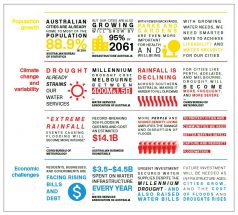State and local government water utilities are turning to new technology and partnerships with private and community groups to meet supply challenges arising from population growth and climate change.
That’s according to an analysis of Australian water utilities by the Cooperative Research Centre for Water Sensitive Cities, which concludes that agencies are “taking proactive steps” to meet future challenges.
The paper, based on the CRC’s research, detailed a range of collaborations and innovations across both state-owned and local government water utilities. It found that agencies are changing internal operations and culture, adopting new business models and engaging with external groups.
The CRC, which is based at Monash University, said there is now a “significant body of evidence” showing that state-owned enterprises, which have responsibility for water and sewerage services in most Australian cities, are “transforming from within”.
“Technological, financial and cultural commitment to innovation are common elements in these transformations,” the report stated.
These entities are using automation and digital technology to improve their traditional water utilities services, it said.
The paper pointed to the WA Water Corporation’s use of smart water meters and big data diagnostics to better manage water utilisation in Kalgoorlie. This facilitated a behaviour change campaign that influenced customer demand, particularly during warmer months.
Similarly, the researchers cited South East Water’s use of pressure sewers to overcome wastewater pollution from septic systems on the Mornington Peninsula:
“South East Water is rolling out one of the largest pressure sewer constructions in Australia, covering 16,500 properties… It reduces wastewater pollution released into the environment, and allows South East Water to better use its existing mains sewer network.”
Partnerships with business, community
Some state-owned water utilities are successfully partnering with the private sector to develop new business models, while others are initiating various public-private and community partnerships.
For instance, the researchers noted that communities in Melbourne can apply to use Melbourne Water land for community-building activities, through the organisation’s Our Space Your Place initiative.
“The community benefits from improved access to open spaces, while Melbourne Water improves it assets and its capacity to engage and service the community,” they concluded.
Local government entities also innovating
But it’s not just large state-owned water utilities displaying innovative practices, with many local government water entities similarly transforming how they work, the researchers found.
NSW has 100 municipal government owned water providers in rural and regional areas, while all service providers in Queensland are owned by municipal governments, the paper noted.
“The Australian experience shows geographic locations, size and ownership are not barriers to applying water sensitive principles that deliver a better result for communities,” the analysis found.
“Small municipal water utilities are taking advantage of innovative ways to better use their existing infrastructure to deliver services.”
It pointed to Mackay Regional Council, which introduced digital communications technology to track consumption and then manage demand for water, particularly during peaks.
Likewise, in the face of increased water demand from industry and community, the City of Salisbury has responded by managing harvested stormwater and wastewater.
“This water services parks, schools, industry and residential properties,” the report said.
Traditional approaches won’t cut it
The analysis concludes that traditional water management approaches will not meet the challenges facing water utilities, which include rapid population growth, climate change and demand for affordable services.
The authors argued that water utilities must keep transforming themselves internally, through culture change, integrating existing services and identifying new products and services.
They must also keep engaging with external bodies, such as other water utilities, private sector providers and community groups.
Finally, the researchers argued that water utilities must influence policy, regulation and funding by demonstrating how new service delivery methods benefit both providers and the community.

Comment below to have your say on this story.
If you have a news story or tip-off, get in touch at editorial@governmentnews.com.au.
Sign up to the Government News newsletter.




Leave a Reply